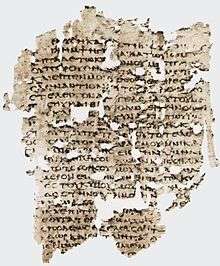Papyrus Oxyrhynchus 656

Papyrus Oxyrhynchus 656 (abbreviated as P.Oxy.IV 656) – is a Greek fragment of a Septuagint manuscript written on papyrus in codex form. This is a manuscript discovered at Oxyrhynchus, and it has been catalogued with number 656. Palaeographycally it is dated to late second century or early third century.
The fragments contains Genesis (14:21-23, 15:5-9, 19:32-20:11, 24:28-47, 27:32,33,40,41), written in Koine Greek. On places where occurs the tetragrammaton is the word kyrios written, a nomina sacra, the characters are different than other. A second writer is believed to have deleted the tetragramaton and replaced it with KY, because the space is bigger. The mss. Papyrus Rylands 458 has been used in discussions about the tetragrammaton, although there are actually blank spaces in the places where some scholars including C. H. Roberts believe that it contained letters.[1] According to Paul E. Kahle, the tetragrammaton must have been written in the manuscript where these breaks or blank spaces appear.[2] The manuscript was written on papyrus, in codex form. The surviving fragments are four pieces of 24 cm by 20 cm.
History
The fragment was published in 1904 by Bernard P. Grenfell and Artur S. Hunt in The Oxyrhynchus Papyri, vol IV. The number 905 was given to the fragments list of septuagint manuscripts according classification system of Alfred Rahlfs.